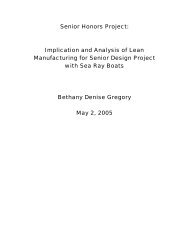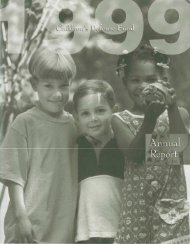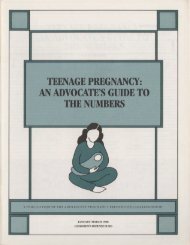child care - Digital Library Collections
child care - Digital Library Collections
child care - Digital Library Collections
You also want an ePaper? Increase the reach of your titles
YUMPU automatically turns print PDFs into web optimized ePapers that Google loves.
.... 8 POT L I G H TON ED U CAT ION<br />
scores between 17·year-ld Black and White students was reduced by more than half between<br />
1971 and 1988. Had progress continued at the same pace throughout the 1990s, the scores for<br />
the two groups would have equalized in 1998. Unfortunately, gains leveled off, and as the end of<br />
the decade approaches, the reading score gap remains about where it was at the beginning.<br />
Similarly, the National Education Goals Report released in 1997 indicates essentially no<br />
change in the number of high school graduates between 1990 and 1996. Each school day more<br />
than 2,700 students drop out.<br />
Although more young people ofall racial, ethnic, and economic backgrounds attend college<br />
today, only one in three high school graduates completes a college degree (compared with about<br />
one in four in 1973). That leaves two-thirds of high school graduates without the education<br />
necessary for the majority of new jobs in the next century. Children from low-income families<br />
in particular often lack the means and the encouragement to pursue higher education. The<br />
most recent data from the U.S. Department of Education (DOE) indicate that only about<br />
one-third ofyouths from low-income families are in college in the October following high school<br />
graduation, compared with more than 80 percent from high-income families. The DOE also<br />
reported that in 1996 the percentage ofWhite high school graduates who completed a four-year<br />
college degree was double that ofBlacks and Hispanics.<br />
Just as a college degree is becoming more critical to obtaining a well-paying job, higher<br />
education costs have escalated, soaring beyond the reach ofmany low-income students. According<br />
to the Education Trust, average tuition and fees at public two-year colleges, the least<br />
expensive higher education option, have more than tripled since 1980. Costs at four-year public<br />
colleges have risen to more than three and a half times their 1980 levels. Meanwhile, student<br />
financial assistance has shifted from grants to loans. In 1979 the maximum federal Pell grant to<br />
low-income students covered 77 percent ofthe average cost ofattending public college; in 1993,<br />
only 35 percent. In 1998, as Congress considers reauthorization of the Higher Education Act,<br />
it will have an important opportunity to make higher education more attainable for all students.<br />
Despite repeated commissions, studies, and reports, efforts to improve America's schools<br />
seem to have stalled. In 1990 President Bush and the 50 governors established education goals<br />
for the year 2000. The 1997 report of the National Education Goals Panel, however, showed<br />
slim progress in six areas, deterioration in seven, and no change in seven others. In 1997<br />
President Clinton and Congress struggled over the mechanism for establishing national standardized<br />
tests to measure academic achievement but paid little attention to ensuring that<br />
students actually learn.<br />
Shortchanging poor and minority <strong>child</strong>ren. While the nation's overall educational outlook is<br />
cause for concern, the plight of poor <strong>child</strong>ren and minority <strong>child</strong>ren is even bleaker. As<br />
disparities in school performance appear to be growing again, some suggest that nonschool<br />
problems such as poverty, family turmoil, violent neighborhoods, and drug abuse explain the<br />
lagging performance of disadvantaged <strong>child</strong>ren. These conditions do take a heavy toll. Two<br />
recent CDF publications, Poverty Matters and Wasting America's Future, document how poverty<br />
robs poor <strong>child</strong>ren of educational opportunities. Good schools, however, can help <strong>child</strong>ren<br />
transcend difficult circumstances.<br />
(continued on the following page)<br />
CHI L D R EN' 8 0 E FEN S E FUN 0 49














